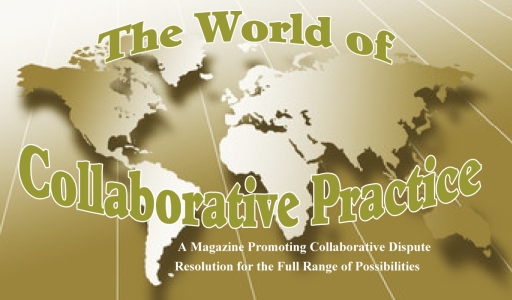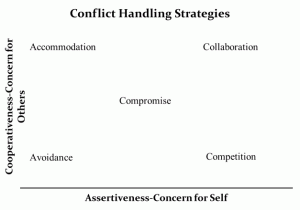
Tags
Related Posts
Share This
Conflict Styles: An Overview
In the heat of a conflict when emotions are high, what do you do? Do you ignore the issues and bury them or do you let the other person have their way?
Human beings are predisposed to respond to conflict in a certain manner. Conflict style is a general way of thinking about and responding to conflict. (Roxanne Lulofs and Dudley Cahn, Conflict: From Theory to Action. Neadham Heights, MA: Allyn & Bacon, 2000.) These choices or conflict styles have been studied by many scholars. Conflict styles are patterned responses or behaviors that have evolved over time. (William Wilmot and Joyce Hocker, Interpersonal Conflict. New York, NY: McGraw Hill, 2011.) The most popular classification scheme is that developed by Kenneth Thomas and Ralph Kilmann over 35 years ago. This article will review each of these styles and give an example of the process of resolving a conflict with knowledge and understanding of these styles.
Interpersonal conflict and the response thereto resides in a two dimensional space which blends the needs of the self and the other. Assertiveness is the vertical axis measuring the concern for self and cooperativeness is the horizontal axis measuring the concern for the other party in conflict. Within this space lies the five different conflict styles: avoidance, accommodation, compromise, competition and collaboration. All of these styles have useful purposes in certain situations. The challenge is to know when to vary your style.
Avoidance A person who avoids conflict has a low concern for herself and for others. In the two-dimensional space they are uncooperative and unassertive. Someone who uses avoidance has the ability to side step problems, leave issues unresolved, and allow others to take ownership. If an issue is unimportant avoidance may be the correct strategy. However, if you continually avoid conflicts it is like a simmering pot that will eventually boil over.
Accommodation The skills of an accommodator are selflessness, obedience and an ability to yield. Accommodation is useful when you want to create goodwill or show reasonableness. If it is overused it can result in restricted influence, loss of contribution, overlooked ideas and anarchy. If it is underused it can result in low morale and lack of rapport among colleagues.
Competition The competitor is easy to recognize. Winning is the name of their game and they are only concerned about their own needs. They are at the top of the assertiveness scale and low on the cooperativeness scale. A competitive strategy is good in emergencies or other instances when quick decisions need to be made. Competitors use rank, position and influence and state their positions, opinions and feelings clearly. When competition is overused the environment is characterized by a lack of feedback, low empowerment and reduced learning. If competition is underused, indecision or delayed action could have a crippling effect on an organization
Compromise The compromiser is seeking ways to make a deal and meet halfway. In compromise each side’s needs are only partially met. In the two dimensional space it lies in the middle. A compromiser demonstrates skills of moderation and negotiation. An overuse of compromise means a loss of the big picture perspective and lack of trust. If it is underused there may be frequent power struggles and unnecessary confrontations.
Collaboration Sometimes referred to as the ideal alternative, collaboration is high on the assertiveness and cooperativeness axis. A collaborator demonstrates reasonableness and an ability to listen, understand and empathize. Lack of commitment, low empowerment and loss of innovation can take place when there is insufficient collaboration. On the other hand, when collaboration is overused there may be too much time spent on trivial matters and extra work created as a result. Collaboration takes time and energy to correctly execute.
Case Example of Working With Conflict Styles in Your Practice
Susan and Rhonda, who are sisters, come to your office for mediation. They have been arguing a lot lately about the care of their elderly mom who’s still lives alone in the family’s home In a Chicago suburb. Neither daughter lives nearby. Susan is the eldest and is used to using her position in the family to influence her sister and mom. Her preferred conflict strategy is competition. Susan thinks her mom should move to a senior facility convenient to her home. Rhonda wants what mom wants which changes every day depending on mom’s moods and needs. Rhonda is unassertive and avoids conflict. Susan doesn’t have patience for her sister’s indecision. Rhonda is frustrated that her sister is once again trying to take control and doesn’t like to argue with her. She agreed to come to mediation after much hesitation.
As mediators or collaborative professionals working with this pair your central task is to get each sister to recognize the legitimacy of each one’s perspective as well as their common interest in their mom’s well-being. Doing a quick gut level assessment of their preferred methods of handling conflict may help you help them to identify their individual and common needs. The dispute resolution professional might pose the following inquiries: “Tell us more about what you envision for mom and how you’ve come to that conclusion.” “What is your thinking about the different options for your mom’s future needs?” “What worries each of you about the other’s preferred options for your mom?” “What discussions have you each had with your mom about her living arrangements?” “How can you involve your mom in this discussion?”
These are just some possible questions. The goal should be to get the sisters off their individual interests and focus instead on mom’s long term needs and her future. This would move them towards problem solving, rather than bickering.
Theory application tips
Knowledge of conflict strategies gives you power and control over your responses.
Give yourself time to think about your response to a conflict situation.
Assess the costs and benefits of using a given strategy.
Determine if you have the behavioral skills to employ a given strategy.
If using a given strategy in a particular situation is new for you, rehearse your response beforehand.
If the issues will impact many parts of the organization allow for enough time to develop a collaborative approach.










Share your thoughts here and in your network.